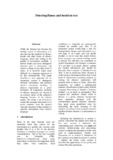| dc.contributor.author | Mahmud, Altaf | |
| dc.contributor.author | Ahmed, Kazi Zubair | |
| dc.contributor.author | Khan, Mumit | |
| dc.date.accessioned | 2011-01-17T05:10:50Z | |
| dc.date.available | 2011-01-17T05:10:50Z | |
| dc.date.copyright | 2008 | |
| dc.date.issued | 2008-12 | |
| dc.identifier.uri | http://hdl.handle.net/10361/714 | |
| dc.description | Includes bibliographical references (page 10). | |
| dc.description.abstract | While the internet has become the leading source of information, it is also become the medium for flames, insults and other forms of abusive language, which add nothing to the quality of information available. A human reader can easily distinguish between what is information and what is a flame or any other form of abuse. It is however much more difficult for a language processor to do this automatically. This paper describes a new approach for an automated system to distinguish between information and personal attacks containing insulting or abusive expressions in a given document. In linguistics, insulting or abusive messages are viewed as an extreme subset of the subjective language because of its extreme nature. We create a set of rules to extract the semantic information of a given sentence from the general semantic structure of that sentence to separate information from abusive language. | en_US |
| dc.description.statementofresponsibility | Altaf Mahmud | |
| dc.description.statementofresponsibility | Kazi Zubair Ahmed | |
| dc.description.statementofresponsibility | Mumit Khan | |
| dc.format.extent | 10 pages | |
| dc.language.iso | en | en_US |
| dc.publisher | BRAC University | en_US |
| dc.subject | Language processing | |
| dc.title | Detecting flames and insults in text | en_US |
| dc.type | Article | en_US |
| dc.contributor.department | Center for research on Bangla language processing (CRBLP), BRAC University | |

